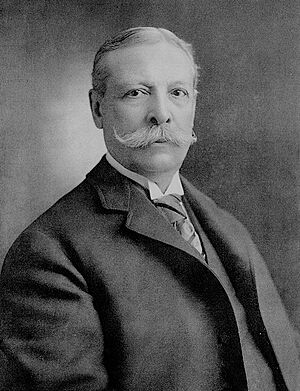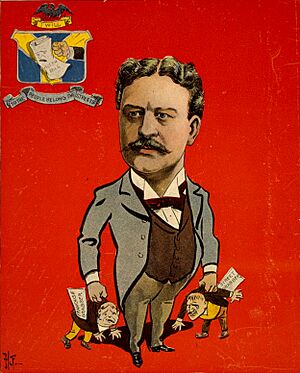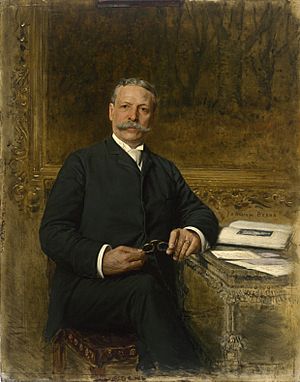Charles Yerkes facts for kids
Quick facts for kids
Charles Yerkes
|
|
|---|---|
 |
|
| Born |
Charles Tyson Yerkes
June 25, 1837 Northern Liberties, Pennsylvania, U.S.
|
| Died | December 29, 1905 (aged 68) New York City, New York, U.S.
|
| Occupation | Entrepreneur and investor |
| Known for | Urban transit finance |
| Spouse(s) |
|
| Parent(s) | Charles Tyson Yerkes Sr. and Elizabeth Link Yerkes |
| Signature | |
Charles Tyson Yerkes Jr. (born June 25, 1837 – died December 29, 1905) was a very important American businessman. He helped create and improve public transportation systems in big cities like Chicago and London. He was known for his smart, sometimes tricky, ways of doing business.
Contents
Early Life in Philadelphia
Charles Yerkes was born in Northern Liberties, a part of Philadelphia, on June 25, 1837. His family were Quakers. When he was five, his mother passed away.
He finished school at Central High School in Philadelphia. At age 17, he started working as a clerk in a company that traded grain. By 22, he opened his own business and joined the Philadelphia stock exchange.
By 1865, Yerkes moved into banking. He focused on selling bonds for cities, states, and the government. He used his father's connections and his own sharp mind to become well-known in the financial world.
However, Yerkes faced a big problem. While handling money for the City of Philadelphia, he used public funds for a risky stock deal. This deal went wrong after the Great Chicago Fire caused a financial panic. Yerkes couldn't pay the city back. He was found guilty of a financial offense and spent seven months in prison. He was released after agreeing to deny some accusations he had made against political leaders.
Building Transit in Chicago

In 1881, Yerkes moved to Chicago and remarried. He started a business trading stocks and grain. Soon, he became very involved in Chicago's public transportation.
By 1886, Yerkes and his partners took control of the North Chicago Street Railway. They continued to buy more companies until they controlled most of Chicago's street railway systems. He was known for using clever business tactics to get what he wanted.
To improve his public image, Yerkes decided to fund the world's largest telescope in 1892. He worked with George Ellery Hale, an astronomer, and the president of the University of Chicago. Yerkes gave nearly $300,000 to the University of Chicago. This money helped create the Yerkes Observatory in Williams Bay, Wisconsin.
In 1895, Yerkes bought a newspaper called the Chicago Inter Ocean. He used the newspaper to support his business and political goals.
Yerkes tried to get longer contracts for his streetcar lines in 1895. The governor of Illinois stopped these plans. He tried again in 1897 and managed to get a bill passed. This bill allowed city councils to approve longer contracts. However, the Chicago City Council eventually stopped Yerkes's plans.
In 1899, Yerkes sold most of his Chicago transportation stocks and moved to New York.
Collecting Art
While living in Chicago, Charles Yerkes became a big art collector. He had an advisor named Sarah Tyson Hallowell who helped him choose pieces. After the Chicago World's Fair in 1893, he bought two sculptures by Auguste Rodin. These were some of the first Rodin works sold to an American collector.
His art collection also included paintings by famous artists like Frans Hals and Jean-Léon Gérôme. In 1904, he published a two-volume book showing all the art in his collection.
Developing London's Underground
In 1900, Yerkes became involved in building the London Underground railway system. He rode along the paths of planned lines and looked at the city from Hampstead Heath. He then created a company called the Underground Electric Railways Company of London.
His company took control of the District Railway and other lines that were being built. These included the Baker Street and Waterloo Railway, Charing Cross, Euston and Hampstead Railway, and Great Northern, Piccadilly and Brompton Railway. Yerkes used smart financial plans, similar to those he used in the United States, to get the money needed to build these new lines. He also helped electrify the District Railway, which is now known as the District line.
Yerkes even managed to stop another powerful financier, J. P. Morgan, from getting involved in London's underground railways. Charles Yerkes passed away before his London tube lines were fully open. The Bakerloo line and Piccadilly line opened in 1906, a few months after his death. The Charing Cross line (now part of the Northern line) opened the following summer.
Death and Legacy
Charles Yerkes died in New York City on December 29, 1905, from kidney disease. His life story inspired the author Theodore Dreiser to write a series of novels. In these books, Yerkes was portrayed as a character named Frank Cowperwood.
A crater on the Moon is named Yerkes in his honor.
Yerkes and his second wife, Mary, were painted by his favorite artist, Jan van Beers.
Images for kids


